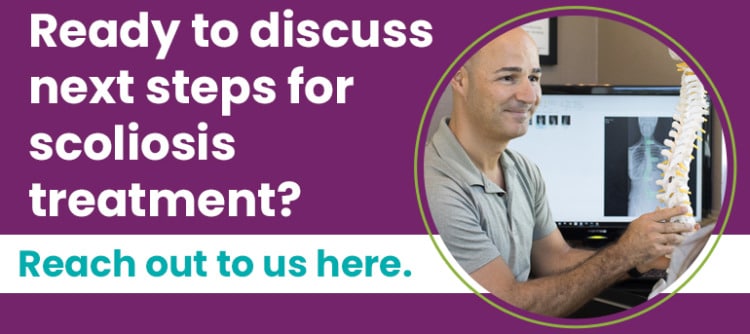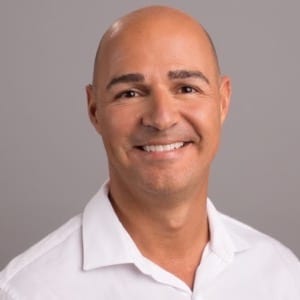Extreme Scoliosis: Understanding Severe Spinal Curvatures
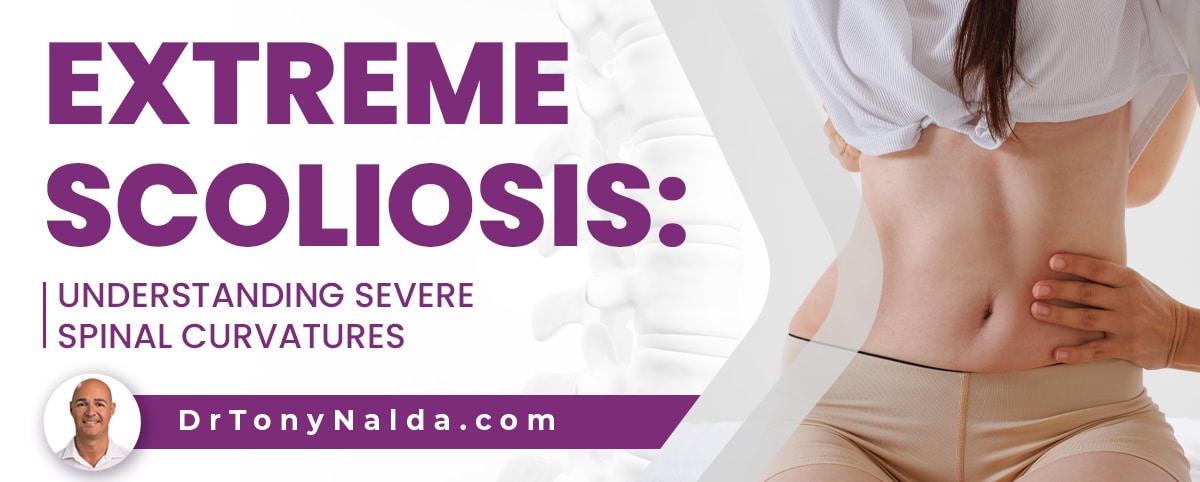
Scoliosis patients have an unnatural sideways-bending curvature of the spine that also twists, but the size of the curve can range widely. Understanding condition severity involves a measurement known as Cobb angle; continue reading to learn how it's determined and what it means.
Scoliosis ranges widely in severity from mild scoliosis to moderate, severe, and very severe scoliosis. Extreme scoliosis means the size of the unnatural spinal curve has a Cobb angle measurement of 80+ degrees and can also involve atypical condition types such as neuromuscular scoliosis.
Extreme scoliosis can have overt effects and can cause complications, particularly if left untreated.
Table of Contents
What is Extreme Scoliosis?
When scoliosis is first diagnosed, part of the process involves comprehensively assessing conditions based on a number of factors and classifying them accordingly.
Condition severity is an important variable treatment plans are shaped around, and it's based on a measurement determined during X-ray that tells me how far out of alignment a scoliotic spine is.
Cobb angle is determined by drawing lines from the tops and bottoms of the curve's most-tilted vertebrae, and where those lines intersect is an angle that's expressed in degrees.
So the higher a patient's Cobb angle, the more unnaturally tilted the spine's vertebrae are, the more severe the condition, and the more noticeable its effects are going to be.
Very severe scoliosis is diagnosed with Cobb angle measurements of over 80 degrees, and this means the curve is extreme, and this can involve idiopathic scoliosis, the most common type, and/or typical condition types that are known for their severity.
Atypical Scoliosis
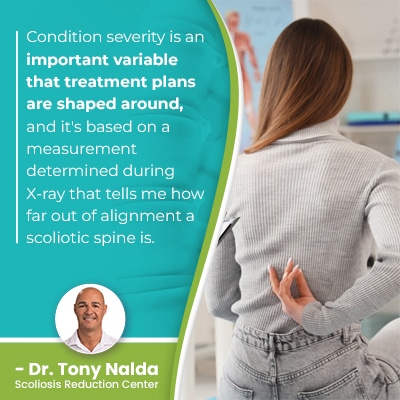 In addition to condition severity, condition type is another factor treatment plans are shaped around, and this is determined by causation.
In addition to condition severity, condition type is another factor treatment plans are shaped around, and this is determined by causation.
The most common type of scoliosis to affect all ages is idiopathic scoliosis, and idiopathic means not clearly associated with a single-known cause.
Approximately 80 percent of known cases involve idiopathic scoliosis, and the remaining 20 percent are associated with known cases and are considered atypical.
Part of the reason these condition types are considered atypical is because they can be particularly severe and have atypical curve types.
In typical cases of idiopathic scoliosis, the curve bends to the right, away from the heart (dextroscoliosis), but in atypical condition types, curves can bend to the left, towards the heart (levoscoliosis).
When I see a left-bending curve on an X-ray, this is a red flag that there is a larger condition behind the scoliosis.
Atypical Condition Types
Atypical condition types with known causes include neuromuscular scoliosis, degenerative scoliosis, and congenital scoliosis.
Degenerative scoliosis is caused by natural age-related spinal degeneration and the cumulative effect of certain lifestyle factors.
As degenerative scoliosis affects older adults, it can be particularly severe as the spine becomes increasingly unbalanced and unstable.
Congenital scoliosis is caused by a malformed spine and develops in utero; this type can be particularly severe because babies are born with the condition.
Spinal malformations can include vertebral bodies failing to separate and instead forming into one solid bone and/or vertebrae being more triangular in shape than rectangular; either of these issues can disrupt the spine's ability to develop healthy curves and form in a straight and neutral alignment.
Neuromuscular Scoliosis
Of the different condition types, neuromuscular scoliosis patients tend to be the most extreme cases to treat, and this is because the scoliosis has developed as a secondary complication of a larger neuromuscular disease.
There are a number of neuromuscular conditions capable of causing the development of scoliosis including spina bifida, muscular dystrophy, and cerebral palsy.
As the larger condition causes scoliosis to develop, the neuromuscular condition has to be the focus of treatment, and neuromuscular scoliosis can be particularly extreme.
Neuromuscular conditions cause a disconnect between the brain and the muscles/ligaments/tissues that support the spine, disrupting its ability to stay aligned and balanced.
Some neuromuscular scoliosis patients become non ambulatory (unable to walk on their own)
Symptoms of severe and extreme scoliosis can be overt.
Symptoms of Extreme Scoliosis
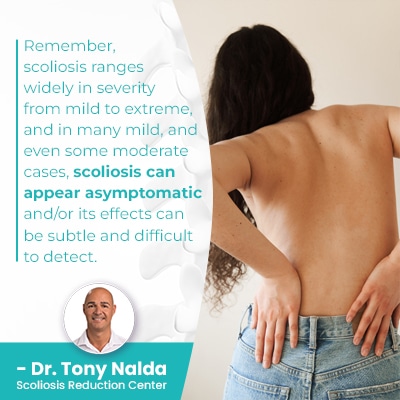 Remember, scoliosis ranges widely in severity from mild to extreme, and in many mild, and even some moderate cases, scoliosis can appear asymptomatic and/or its effects can be subtle and difficult to detect.
Remember, scoliosis ranges widely in severity from mild to extreme, and in many mild, and even some moderate cases, scoliosis can appear asymptomatic and/or its effects can be subtle and difficult to detect.
As a progressive condition, the nature of scoliosis is to get worse over time, and this means the size of the unnatural curve is increasing, as are its effects.
As the spine gives the body structure and balance, when it's unnaturally curved and bent, it doesn't just disrupt the alignment of the spine, but also the spine's surroundings, and the more severe it is, the more that misalignment will be felt from the head to the feet.
The main visual effect of scoliosis involves postural changes caused by the condition's uneven forces disrupting the body's overall symmetry.
No two cases will be the same, but common postural changes associated with severe scoliosis can include:
- A tilted eye line
- The head being uncentered over the torso
- Uneven shoulders
- Uneven shoulder blades
- Development of a rib cage arch (one side of the rib cage jutting forward excessively)
- Uneven hips
- Pelvic obliquity (asymmetrical pelvis)
- Arms and legs hanging at different lengths
As scoliosis progresses and becomes more extreme, these types of changes become more noticeable, and disruptions to movement can affect coordination, balance, and gait.
When scoliosis is severe and compressive, once skeletal maturity has been reached, pain management will be necessary, and as the brain and spine work in tandem to form the body's central nervous system, neurological symptoms are also associated with severe scoliosis.
Potential Complications of Extreme Scoliosis
If scoliosis is left untreated, it's virtually guaranteed to progress at some point, and the more severe a condition is, and the longer it's left untreated, the more likely it is that related complications can develop, in addition to increasing condition effects.
No two cases are the same; what one patient experiences doesn't necessarily indicate what others will face, and as a progressive condition that's always changing, effects and complications can also change.
Breathing Problems
In severe and extreme cases, lung function can be affected, and this is most closely associated with thoracic scoliosis; as the thoracic spine is the only spinal section to attach to the rib cage, if the unnatural twist and bend in the spine is disrupting the position of the rib cage, it can compress the lungs within.
In atypical cases of scoliosis like neuromuscular scoliosis, lung impairment is also more likely because curves can be left-bending.
Additional complications can include cardiovascular issues - again, more closely associated with cases of levoscoliosis.
Headaches/Migraines
Headaches and migraines are also symptoms of extreme scoliosis as the unnatural bend and twist in the spine can disrupt the flow of cerebrospinal fluid between the spine and in and around the brain.
Digestive Problems
Digestive issues can also develop as contortion and compression can affect the stomach, organs, and muscles involved in digestion.
Scoliosis doesn't just affect the spine and its immediate surroundings, it can also affect a number of working parts and systems within the body, and the best way to minimize the potential effects of scoliosis is to treat it proactively and address its underlying cause, when known.
Conclusion
A big risk of leaving scoliosis untreated is that even if it's initially diagnosed as mild scoliosis, it can become moderate scoliosis, severe scoliosis, or even extreme scoliosis.
A potential effect of allowing progression to occur unimpeded is that scoliosis surgery can be necessary in the future.
While spinal fusion surgery can indeed achieve spinal deformity correction, the way it does so is contrary to the spine's movement-based design, and when it comes to treating adolescent idiopathic scoliosis with surgery, the younger a patient is at the time of the procedure, the longer the hardware used has to perform optimally; spinal fusion surgery involves fusing the curve's most-tilted vertebrae into one solid bone and attaching metal rods to the spine to hold it in place.
Scoliosis treatment will shape the spine's long-term health, and when it comes to severe scoliosis symptoms, the best way to prevent mild scoliosis from becoming severe scoliosis is to treat it proactively.
Spinal curve progression can be managed effectively, particularly with early diagnosis and intervention, and while there are no treatment guarantees, abnormal spinal curvatures can be highly treatable.
So the best time to treat scoliosis is immediately following a diagnosis, when conditions are going to be at their mildest and most responsive, and here at the Scoliosis Reduction Center® diagnoses are responded to with immediate proactive non surgical intervention.
Dr. Tony Nalda
DOCTOR OF CHIROPRACTIC
After receiving an undergraduate degree in psychology and his Doctorate of Chiropractic from Life University, Dr. Nalda settled in Celebration, Florida and proceeded to build one of Central Florida’s most successful chiropractic clinics.
His experience with patients suffering from scoliosis, and the confusion and frustration they faced, led him to seek a specialty in scoliosis care. In 2006 he completed his Intensive Care Certification from CLEAR Institute, a leading scoliosis educational and certification center.
About Dr. Tony Nalda
 Ready to explore scoliosis treatment? Contact Us Now
Ready to explore scoliosis treatment? Contact Us Now